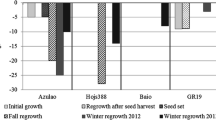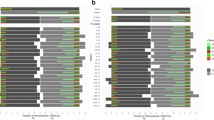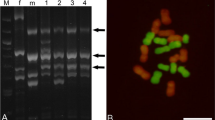Abstract
Paspalum is an important genus of the family Gramineae that includes several valuable forage grasses. Many of the species are polyploid and either obligate or facultative apomicts. Cyto-embryological observations of several tetraploid genotypes of P. notatum were performed to determine their mode of reproduction. Afterwards, selfed progenies of the genotypes F131, Q3664 and Q4117 were analysed using RFLP and RAPD genetic fingerprints to identify maternal and non-maternal (aberrant) plants, and to establish the degree of apomictic reproduction. Five maize clones and six primers were used for detecting genetic deviations from the maternal profile. Maize clones umc379, umc384 and umc318 and primers OPG10 and OPI4 were the most informative for discriminating between maternal and aberrant individuals within the progenies of F131 and Q3664. The combined results of three RFLP clones or 4–6 RAPD primers were necessary to ascertain the mode of reproduction in plants F131 and Q3664. The results obtained with the RFLP and RAPD markers were in agreement with the cyto-embryological studies in ascertaining the mode and degree of apomictic reproduction. Plant F131 showed a completely sexual reproductive behaviour, Q3664 an elevated expression of sexuality, while Q4117 was highly apomictic. A fingerprint analysis of an outcrossing population, aimed at the identification of hybrid plants, was also performed. Maize clones um318 and umc379 and primers OPC2 and OPC9 were used. The presence of specific bands belonging to the male parent permitted a rapid and easy detection of hybrids. The methodology described here can be applied both for the characterisation of P. notatum populations and to identify hybrid progenies in Paspalum breeding programs.
Similar content being viewed by others
Author information
Authors and Affiliations
Additional information
Received: 5 March 1997 / Accepted: 13 May 1997
Rights and permissions
About this article
Cite this article
Ortiz, J., Pessino, S., Leblanc, O. et al. Genetic fingerprinting for determining the mode of reproduction in Paspalum notatum, a subtropical apomictic forage grass. Theor Appl Genet 95, 850–856 (1997). https://doi.org/10.1007/s001220050635
Issue Date:
DOI: https://doi.org/10.1007/s001220050635




